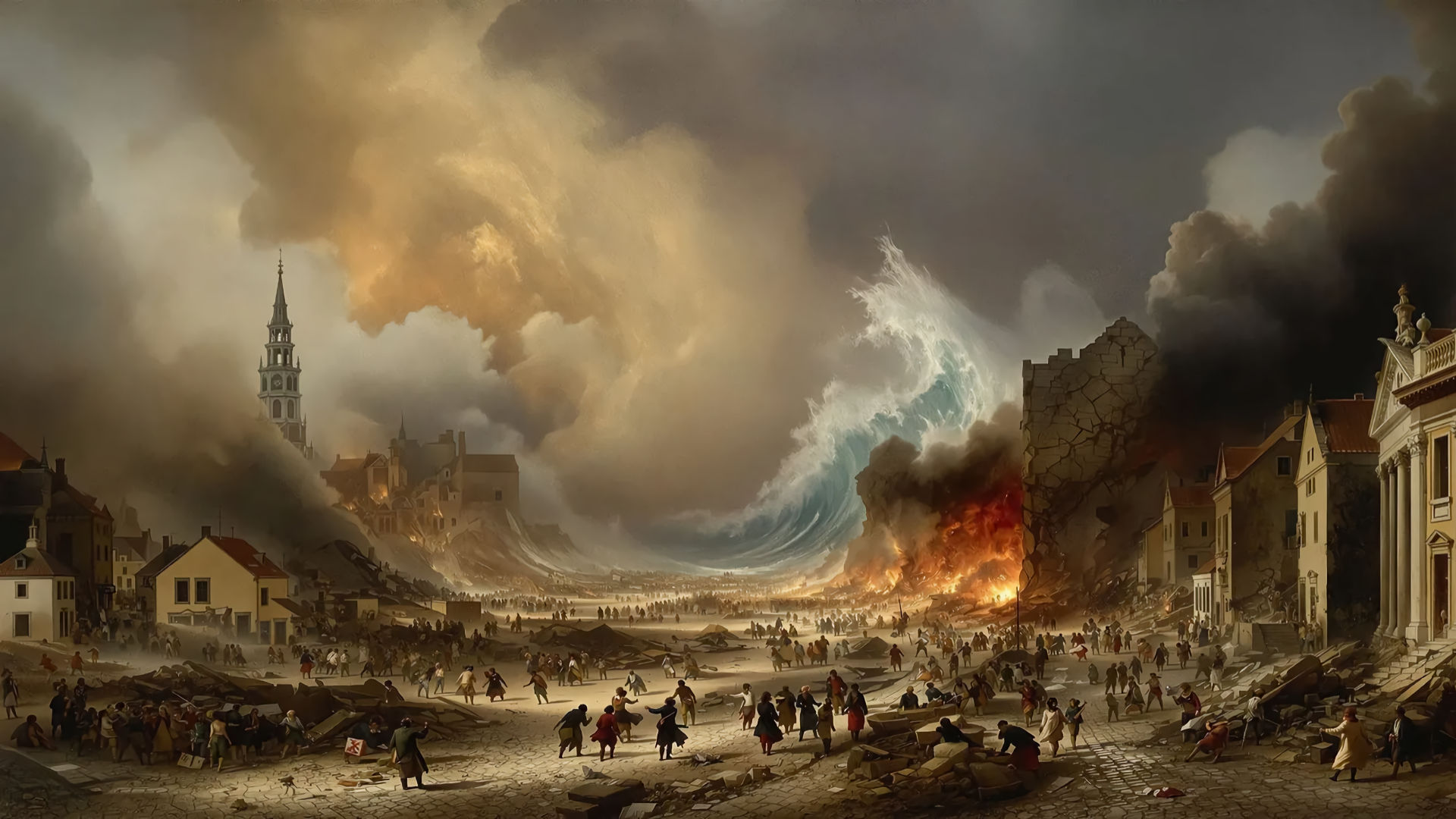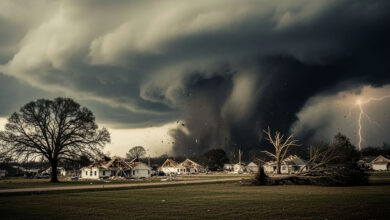The Great Lisbon Earthquake
On the morning of Saturday, 1 November 1755, All Saints’ Day, the city of Lisbon, Portugal, was struck by one of the most devastating natural disasters of early modern Europe. At approximately 9:40 a.m., a massive earthquake tore through the ground beneath the city and the surrounding region, followed by a tsunami and widespread fires. Thousands perished, buildings collapsed, the sea surged into the harbour, and the after-shock of the event would ripple through philosophy, science, politics and the city’s own future.
The Earthquake Strikes
The seismic shock came unexpectedly, yet within minutes, the scale of devastation became obvious. The earthquake’s magnitude is estimated to have been in the range of about 8.5 to 9.0 on the moment magnitude scale, according to modern scientific reconstructions. It is believed the epicentre lay in the Atlantic Ocean off the south-west Iberian margin, possibly near the Azores Gibraltar transform fault. The shaking lasted several minutes. Contemporary sources note fissures up to five metres wide opening in Lisbon’s streets.
In Lisbon, many of the faithful were in church for the holy day, and as many as a third of the city’s buildings were destroyed or badly damaged. Estimates vary, but damage in the city and surrounding areas was catastrophic. The quake alone would have been deadly, but the cascading effects turned it into a catastrophe of extraordinary scale.
The Sea Recedes, Then Strikes
After the ground stopped shaking, many of Lisbon’s residents rushed to the open spaces along the Tagus River, believing safety lay in open air rather than collapsing buildings. But their relief turned to horror when the sea itself betrayed them. Roughly 30 to 60 minutes after the initial quake, massive tsunami waves swept inland. Some estimates suggest waves of 5‑to 15 metres or more struck Lisbon’s riverfront and harbour. The waves inundated areas previously thought safe. Ships were tossed, dockyards swamped, and entire quaysides flooded. The tsunami also affected other parts of Portugal, Spain, and North Africa.
Firestorm and Final Collapse
As if nature’s onslaught were not enough, fire added a third destructive dimension to the disaster. Candles and lamps overturned in the quake, igniting many buildings; the spread of the fire was aided by the wreckage and wind. Blocks of Lisbon burned for days, especially in the city’s lower town (Baixa) and waterfront areas. The combination of earthquake, tsunami, and fire obliterated much of Lisbon’s urban core. Contemporary accounts record dramatic scenes of churches collapsing, bodies being burnt or drowned, and mass panic sweeping the city.
Human Cost and Urban Death
Casualty estimates remain imprecise, but the human toll was enormous. Some sources estimate 30,000 to 40,000 deaths in Lisbon alone, with possibly 50,000 or more when surrounding areas and North Africa are included. Many thousands more suffered injuries, homelessness and significant loss of property. The quake’s timing on a religious holiday amplified the tragedy; many people in churches perished, and the collapse of major ecclesiastical buildings added to the death toll.
The loss was not confined to lives. Major cultural landmarks, palaces, archives, art collections and libraries were lost or severely damaged. The destruction of the Royal Ribeira Palace and its valuable holdings is an oft-cited example. Lisbon’s economy and its imperial ambitions were deeply wounded.
Immediate Response and Reconstruction
In the wake of the disaster, the Portuguese state, under the leadership of Prime Minister Marquês de Pombal, mobilised an extraordinary response for the time. Famous for his blunt order “Enterrar os mortos e tratar os vivos” (“bury the dead and care for the living”), he directed relief efforts, cleared debris, and forced rebuilding plans. The rebuilding of Lisbon’s Baixa district became a pioneering example of planned urban reconstruction. Engineers designed so-called “Pombaline” buildings, early versions of earthquake-resistant construction, and broad avenues and squares replaced the narrow medieval streets.
Within a short period, the city began to rise again, but the trauma lingered. Philosophers and the public alike pondered the meaning of the quake, as the old certainties of divine punishment and human dominion were shaken.
Scientific, Philosophical and Economic Consequences
The Lisbon disaster reshaped thinking far beyond Portugal. For thinkers in the Enlightenment era, the quake raised profound questions about the nature of disaster, divine providence and human suffering. Writers such as Voltaire referenced the event in Candide, while the young Immanuel Kant published early work on earthquakes, trying to interpret natural causes rather than divine wrath. In effect, Lisbon helped catalyse modern seismology and systematic inquiry into natural hazards. The Portuguese government’s deployment of parish questionnaires on damage and phenomena is seen as an early form of disaster science. Economically, the quake’s cost has been estimated at as much as 32‑48% of Portugal’s GDP at the time. Politically, the disaster weakened Portugal’s imperial position, diverted resources from overseas ventures, and forced changes in governance and public welfare.
Regional and Global Reach
Although Lisbon was at the epicentre, the quake’s effects reached far beyond. Parts of southern Spain, the Algarve region of Portugal, Morocco’s Atlantic coast and even the British Isles recorded tsunami waves or felt seismic shaking. In Lisbon’s harbour, ships and people observed the sea withdrawing before the wave struck. The event had global ramifications, becoming a reference point for disaster risk, urban planning, and the vulnerability of coastal cities to earthquake-tsunami combinations.
Lessons in Disaster Risk and Urban Design
The Great Lisbon Earthquake remains a benchmark in the study of natural hazards and urban vulnerability. Its lessons include:
- The co-occurrence of earthquake, tsunami and fire: a “triple hazard” scenario.
- The importance of urban design and building standards — the Pombaline reconstruction pioneered anti-seismic features such as wooden internal frames (“gaiola pombalina”).
- The need for accurate data collection as demonstrated by the systematic parish surveys that followed the event.
- The social vulnerability of densely packed urban populations — the poor, those in older buildings, and those attending church at the time, bore the heaviest losses.
- The transformation of disaster into reform — Lisbon’s reconstruction set new standards for planned city design, zoning and building regulation.
Lisbon’s Legacy and Memory
Today, parts of Lisbon’s Baixa district retain Pombaline architecture, designed in the quake’s aftermath. Plaques and memorials remind citizens and visitors of 1 November 1755. The Carmo Convent’s ruined nave remains a visible marker of the destruction. Philosophically, the earthquake remains a metaphor for unpredictable disruption. Its imprint on European thought, literature and science continues. Meanwhile, seismologists recognise the region as still active, and Lisbon remains cautious. Recent studies of the Azores‑Gibraltar fault zone continue to consider the possibility of another large earthquake in this region.
Why It Matters Today
The 1755 Lisbon Earthquake teaches us that disaster risk is not just about natural forces. It is about human settlement, building practices, governance, and sound design. As modern cities face earthquake, tsunami, fire and climate-linked hazards, Lisbon’s experience remains relevant. It underscores that when the ground shakes, society’s vulnerability shakes too. All Saints’ Day in 1755 reminds us that calamity can strike on the brightest of days, and that rebuilding is not simply about replacing what was lost, but about remaking for the future. And so, more than two and a half centuries later, Lisbon’s calm waterfront hides beneath it a story of ruin and renewal, collapse and architectural innovation, terror and hope.
The Great Lisbon Earthquake FAQ
It was a massive earthquake that struck Lisbon on 1 November 1755, followed by a tsunami and days of fires, making it one of Europe’s deadliest natural disasters.
Modern estimates place the quake at magnitude 8.5 to 9.0, with shaking strong enough to destroy much of the city and cause widespread damage across Portugal and beyond.
Thousands died in collapsing buildings, many more were swept away by the tsunami, and fires triggered by the quake burned large sections of the city.
The disaster influenced major Enlightenment thinkers, prompted early scientific approaches to natural hazards, and reshaped theological and philosophical debates about suffering and nature.






